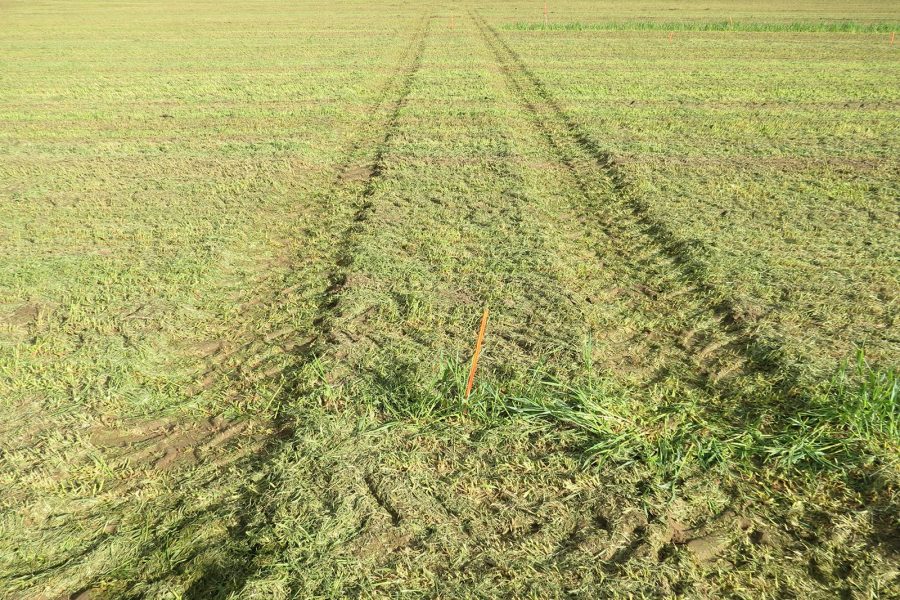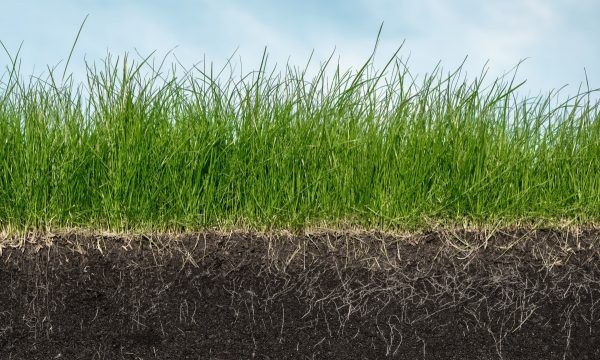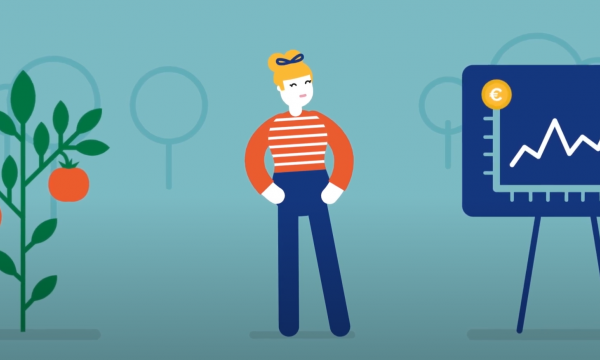Press release Persistent soil compaction under arable fields and grasslands

Compaction of agricultural soils is not only increasing but is also a complex problem. ILVO, Inagro, the Soil Service of Belgium (BDB) and Ghent University are going to investigate in the next 4 years how soil compaction can be remedied sustainably and which measures are economically and also practically feasible. The project partners focus on the two biggest challenges. First is the deeper soil compaction under the topsoil (> 30 cm) for which to date few or no effective and lasting solutions have been found. Second, the wide application of existing soil pressure-reduction techniques, which are not yet breaking through because farmers do not know the real costs and benefits.
Coordinator Tommy D'Hose (ILVO): "Interestingly, in this research project, we are really working with farmers, hired field workers, machine manufacturers and distributors through field experiments to identify which strategies are most effective and feasible. Our immediate aim is the adoption of the tried and tested techniques. And we provide a wide range of investigated situations, with different cultivation techniques, different mechanical innovations, in different combinations. Each time we write down the exact costs and benefits, including fuel consumption."
Interestingly, in this research project, we are really working with farmers, hired field workers, machine manufacturers and distributors through field experiments to identify which strategies are most effective and feasible.

Soil compaction, a growing problem
An estimated 30 to 50% of the most productive and fertile soils in Europe suffer from soil compaction. For Flanders this would amount to an area of 200,000 to 300,000 ha. A recent survey by Belgian farmers also shows that one-third (34%) experience soil compaction problems. Soil compaction happens when soil particles are pressed together by external forces, which decreases the total pore volume in the soil. These pores are important for the transport of air and water through the soil and allow plant roots to pass through. Any type of soil can potentially get compacted, but that risk increases considerably when heavy machinery is used and certainly under wet conditions. Several recent evolutions in the Flemish agriculture are compounding this problem: the trend towards agricultural machinery with larger wheel loads (e.g. self-propelled harvesters), the growth of the vegetable and potato processing industry and the associated evolution to contract cultivation and hired workers that is more aligned with the planning in the factory than the weather conditions, intensive fertilization and mowing of grasslands, the lengthening of the beet growing season, and the increase in maize and potatoes (up to 35% of the agricultural area) which are both harvested late.
Economic and ecological consequences
The relevance of this research is significant: soil compaction is one of the largest physical causes of soil degradation in addition to soil erosion. Impermeable layers in the substrate prevent good rooting and thus hinder crop development. Reported European harvest losses from compaction range from 0.5% up to 50%. In addition, compaction creates problems with the water management on agricultural parcels. In wet periods, the soils can drain less well, which increases the risk of flooding. In dry periods, the crop roots cannot be penetrate to deeper soil and the moisture from the lower layers cannot rise up. That causes drought stress. Considering the predictions from climate studies for longer droughts followed by periods of intense precipitation, planning in good water management becomes more important. Alleviating soil compaction is one important strategy to consider.
There is a big demand for solutions, from policymakers as well as from agriculture. ILVO, Ghent University, the Soil Service of Belgium and Inagro are therefore looking for economically and practically feasible measures that work effectively over the next 4 years. The project focuses on all crops with an increased risk, not only on maize, potatoes and beets, but also on certain vegetable crops and intensively managed grassland.
Goal 1: Evaluate prevention measures and calculate cost benefits
This spring, a first series of field trials were initiated to evaluate preventive measures and to map the associated costs and benefits (including fuel consumption). Tommy D'Hose (ILVO): "Farmers generally consider soil pressure lessening techniques to be expensive and also find it difficult to correctly assess the economic impact of soil compaction because the problem is underground. That is why we are going to make a cost-benefit analysis: What impact does soil compaction have on crop yields? How does that evolve after the different treatments? And what are all the other costs and benefits of the techniques investigated, such as any savings on fuel consumption?"
Left: a print under high tire pressure, and right: a print under low tire pressure. Under low tire pressure, the contact surface is larger, the tire has more grip and the ridges left by the tires are less deep. This reduces fuel consumption. How much exactly will be monitored in this project.
Concretely this year on a practice plot with sugar beet (in cooperation with KBIVB), two maize parcels (ILVO) and an organic vegetable parcel (Inagro), tests are carried out with low pressure tires, air pressure exchange systems, fixed driving paths and machines with multiple axles for better weight distribution. Through the project, techniques will be added in consultation with those involved. Jasper Vanbesien (Inagro): "By involving farmers, hired workers, manufacturers and distributors of machines and tires, we want to focus on feasible techniques and we hope to create awareness. Ultimately, this should lead to a clear overview of good practices and associated costs and benefits. This should allow those concerned to make better informed decisions.'
By involving farmers, hired workers, manufacturers and distributors of machines and tires, we want to focus on feasible techniques and we hope to create awareness.
Goal 2: Find solutions for existing deep soil compaction
In contrast to compaction in the topsoil (0-30 cm), deeper compaction (> 30cm) is harder to alleviate. Normal tillage does not work the soil so deeply. A recent survey by Belgian farmers shows that 30% do not know what measures they should take. In addition, 15% of existing techniques are ineffective.
Nevertheless, the project partners hope to have answers after 4 years. Tom Coussement (BDB): "When is deep tillage successful? Which cover crops should you sow? Does subsoiling (deep ripping) also work on grassland, possibly combined with sowing? And how do you combine that with measures to promote soil life (e.g. earthworms), such as the addition of a soil improver, so that the self-healing capacity of the soil increases again? These are just some of the questions we ask." Like the preventive measures, these remedial measures are made into a cost-benefit analysis.
Goal 3: Terranimo© tool expansion
In addition to a good practice guide and a cost-benefit analysis, this project should provide an improved Flemish version of the existing Terranimo© tool. Terranimo© is a web-based computer model that predicts the risk of soil compaction by agricultural traffic. Users can calculate and visualize the ground tension for different soil texture types, soil moisture levels, tire types and machines. It can therefore be a key decision tool that helps to avoid soil compaction. But first it must find a better entry into Flemish agriculture.
Wim Cornelis (UGent): "To make Terranimo© even more useful for farmers, hired field workers, consultants and researchers, we will add data on new relevant agricultural machinery and tire types. In addition, we will perform field measurements to refine the model parameters even further."
Wanted: farmers with problem plots!
For the tests on deep soil compaction, the project partners are looking for practice plots. Farmers who suspect soil compaction problems in their arable fields or grasslands are encouraged to contact ILVO (tommy.dhose@ilvo.vlaanderen.be) or the Soil Service of Belgium (tcoussement@bdb.be). Participants are closely involved in the construction of the test and the choice of the measures examined. The researchers want to test the techniques that farmers deem most promising and applicable. Furthermore, interference in the common plot management (e.g. fertilization) is kept to a minimum.
About the project
This Flemish LA trajectory started at the end of 2018 and will last for four years (2018-2022). On a regular basis, the results will be communicated via demos, study days, newsletters and the website www.bodemverdichting.be.
The project is funded by the Flemish Government (Vlaio), a number of tire manufacturers (Bridgestone Europe, Michelin Belux, Alliance Tire Europe), agricultural organizations (Boerenbond and ABS), machine manufacturers (Steeno NV), field workers (VDD Agri) and other sector delegates (Bayer Cropscience NV, PRP Technologies-Olmix Group).


